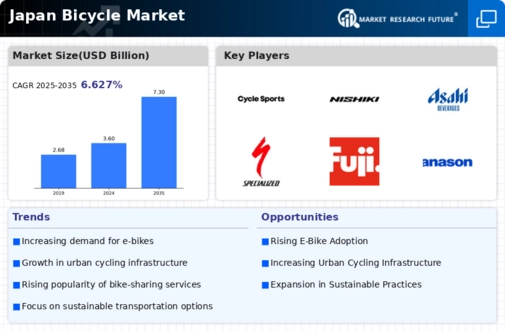Health and Fitness Awareness
The increasing awareness of health and fitness among the Japanese population significantly influences the bicycle market. With a growing emphasis on active lifestyles, more individuals are turning to cycling as a means of exercise and recreation. Recent surveys indicate that approximately 30% of the population engages in cycling regularly for fitness purposes. This trend is further supported by community initiatives promoting cycling events and fitness programs. The bicycle market is poised to capitalize on this health-conscious movement, as manufacturers introduce a variety of bicycles tailored for fitness enthusiasts. Additionally, the rise of cycling clubs and social groups fosters a sense of community, encouraging more people to participate in cycling activities. As health awareness continues to rise, the bicycle market is expected to expand, driven by the demand for bicycles that cater to fitness needs.
Government Policies and Incentives
Government policies and incentives play a significant role in shaping the bicycle market in Japan. Various initiatives aimed at promoting cycling as a viable transportation option have been implemented, including subsidies for bicycle purchases and tax incentives for manufacturers. Recent reports indicate that government funding for cycling infrastructure has increased by 25% over the past year, reflecting a commitment to enhancing cycling accessibility. These policies not only encourage individuals to adopt cycling but also stimulate growth within the bicycle market. Furthermore, local governments are actively organizing cycling events and campaigns to raise awareness about the benefits of cycling. As these supportive measures continue, the bicycle market is expected to flourish, driven by both consumer adoption and industry growth fostered by favorable government actions.
Urbanization and Infrastructure Development
The rapid urbanization in Japan is a crucial driver for the bicycle market. As cities expand, the demand for efficient and eco-friendly transportation options increases. The Japanese government has invested heavily in cycling infrastructure, including dedicated bike lanes and parking facilities. This investment is reflected in the growing number of cyclists, with a reported increase of 15% in urban areas over the past year. The bicycle market benefits from this trend as more individuals opt for bicycles as a primary mode of transport, reducing traffic congestion and pollution. Furthermore, the integration of bicycles into public transport systems enhances their appeal, making them a convenient choice for commuters. As urban areas continue to develop, the bicycle market is likely to see sustained growth driven by these infrastructural improvements.
Technological Advancements in Bicycle Design
Technological advancements play a pivotal role in shaping the bicycle market in Japan. Innovations in materials and design have led to the development of lighter, more durable bicycles, enhancing performance and user experience. The introduction of smart bicycles equipped with GPS tracking, fitness monitoring, and connectivity features has attracted tech-savvy consumers. Recent data suggests that sales of high-tech bicycles have surged by 20% in the last year, indicating a strong market preference for advanced features. The bicycle market is likely to continue evolving as manufacturers invest in research and development to create cutting-edge products. This focus on technology not only appeals to younger demographics but also enhances safety and convenience for all cyclists. As technological integration becomes more prevalent, the bicycle market is expected to thrive, driven by consumer demand for innovative cycling solutions.
Environmental Concerns and Eco-Friendly Practices
Environmental concerns are increasingly influencing consumer behavior in Japan, thereby impacting the bicycle market. As awareness of climate change and pollution rises, more individuals are seeking sustainable transportation alternatives. Bicycles are viewed as an eco-friendly option, contributing to reduced carbon emissions and promoting a healthier environment. Recent studies indicate that approximately 40% of consumers consider environmental impact when purchasing a bicycle. The bicycle market is responding to this shift by emphasizing sustainable manufacturing practices and promoting bicycles as a green transportation solution. Additionally, government initiatives aimed at reducing carbon footprints further support this trend, encouraging more people to choose bicycles over motor vehicles. As environmental consciousness continues to grow, the bicycle market is likely to experience increased demand for eco-friendly bicycles and related products.




















Leave a Comment